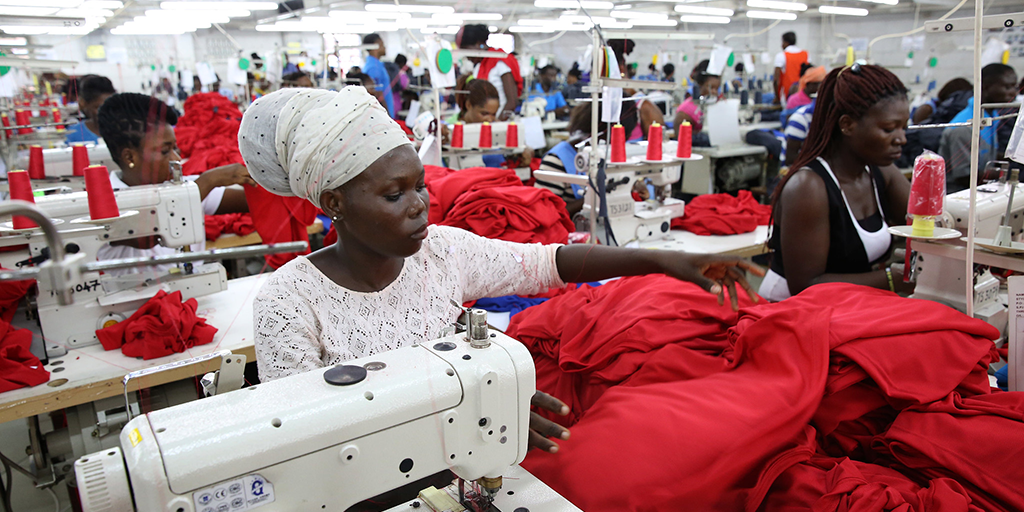The jobs of garment workers across the developing world, such as these women in Ghana, are threatened by the COVID-19 fall-out
Author: Tom Farole
COVID-19 (Coronavirus) is wreaking havoc on firms, which face a triple shock. On the supply side, emergency decrees have shut down many businesses; and movement restrictions have blocked access to labor and other inputs. On the demand side, falling incomes (due to rising unemployment) and wealth (due to deteriorating financial markets) are depressing consumer spending across the board; and in travel and hospitality, demand has collapsed. Firms – especially SMEs – could also face a financial shock, as increased risk and uncertainty block their access to working capital and trade finance, just when they most need it.
Firms faced by falling sales instinctively cut costs to stay in business. The biggest variable cost for most firms is labor. But even when unemployment insurance (which we will discuss in our fourth blog) protects household incomes, cutting jobs still has negative consequences. Without a ready-trained workforce, firms’ ability to respond when market demand returns is reduced; and long-term productivity and innovation may suffer too. Unemployment also has long-term scarring effects on workers’ future earnings and quality of life. So, in a major cyclical downturn, it makes sense to protect both workers and jobs.
How can governments support firms and help save jobs?1 Two characteristics of the COVID-19 crisis matter here. First, the shock is sharp, but if properly managed, it may also be short. Goldman Sachs forecasts a 24% decline in US GDP in the second quarter of 2020 – followed by double-digit growth in the third quarter. If so, interventions should also be big and short. Especially during the initial “outbreak” phase of the crisis, expected to last around 6 months, efficient targeting and potentially-distorting incentives effects matter less than speed. Second, the public health imperative means many firms will stop operating temporarily. The trick is to keep them liquid and solvent, so they can keep workers on their books and quickly re-start. That means helping with cashflow. This suggests two complementary strategies to support firms in the short term: injecting cash; and minimizing their cash outflows. These policies, which have already been applied in many OECD countries, can also work for supporting firms in the developing world.
There are many well-tested public policies for injecting cash into firms, with different pros and cons. Governments can support lines of credit, sometimes at subsidized rates, especially for SMEs. Often, governments provide full or partial credit guarantees to offset the lending banks’ risks. The 2008-10 global financial crisis gave most governments experience in such interventions, and successful models emerged. Sometimes, governments also inject liquidity directly into firms, through loans or grants. When support is needed to prevent bankruptcies in strategic sectors or firms (e.g. in banking, cars, airlines) it is important to balance the public costs and private gains, so the government can take equity positions or nationalize the firm. Recently, Italy announced it would renationalize Alitalia Airlines, and New Zealand bailed out Air New Zealand, with an option to increase its equity stake. Other initiatives during the current crisis include the city of Seattle’s Small Business Stabilization Fund. For informal businesses, without formal banking access, governments can channel cash through microfinance institutions and coop associations; or provide credit through their supply chain links in the formal sector. In Mexico, an innovative supply chain financing scheme uses factoring to provide SMEs and informal firms with access to working capital.
Governments also have a wide range of tools to temporarily reduce firms’ outlays. They can ask banks to allow firms to delay debt payments without penalties. They can also reduce or postpone tax payments or allow for accelerated depreciation to reduce short-term tax liabilities. For example, Singapore’s COVID-19 response offers 25% income tax rebates and faster write-down for investments, while Italy and the US have deferred their annual tax deadlines. Some governments are also allowing firms to defer rent and utilities payments. In China, local governments have waived urban land-use taxes, so landowners can reduce rents. The central government has instructed utilities to lower electricity prices. Finally, governments can accelerate payments to firms on government contracts and reimbursements for VAT and customs duties. In the 2008 financial crisis, the UK government introduced a ‘Prompt Payment Program’ for government suppliers that became standard. Once again, such measures are less relevant for informal firms. However, the temporary suspension of VAT payments for formal firms – as has been done in the COVID-19 response in China – can benefit informal firms in the supply chain.
In our next blog, we will discuss the role of a particularly important tool that many governments have already adopted to help firms to avoid job destruction in the COVID-19 crisis: large scale wage subsidies.
This is the first blog on ways to protect workers and jobs in the COVID-19 (Coronavirus) crisis, based on a World Bank Jobs Group Note: “Managing the Employment Impacts of the COVID-19 Crisis, Policy Options for the Short Term.” Over the next week, we will issue blogs covering: supporting firms; wage subsidies; and safety nets for informal sector workers. In the following weeks, we’ll look at the role of unemployment benefits; active labor market programs; and public works programs that use digital technologies.




